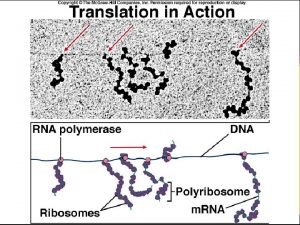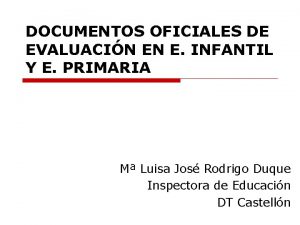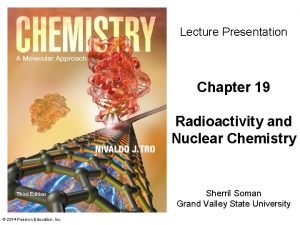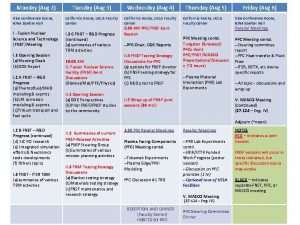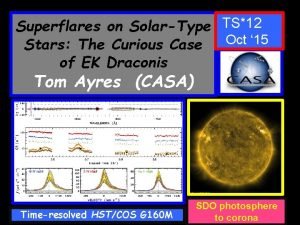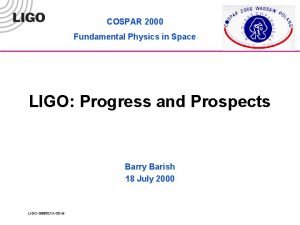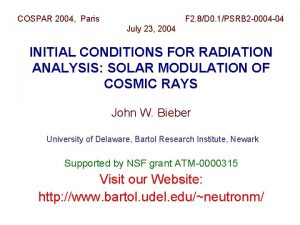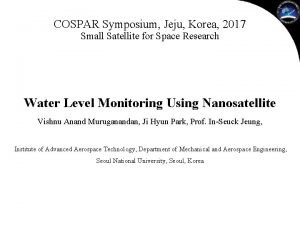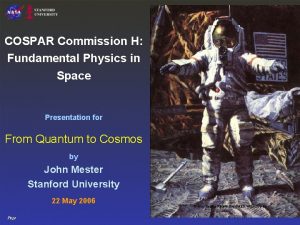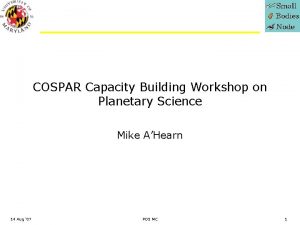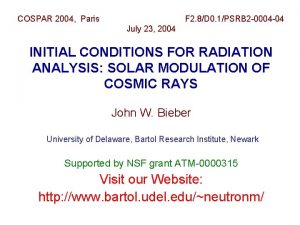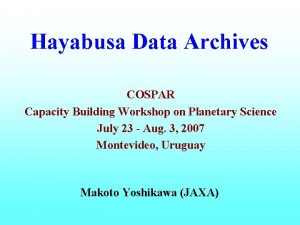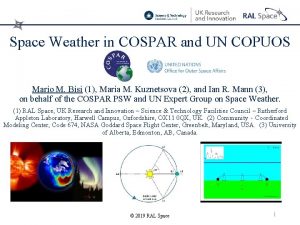COSPAR 2014 Moskow 2014 Aug 7 Superflares on

















- Slides: 17

COSPAR 2014, Moskow 2014 Aug 7 Superflares on Solar type Stars and Their Impacts on Habitability of Exoplanets Kazunari Shibata Kwasan and Hida observatories, Kyoto University Hiroaki Isobe Unit of Synergetic Studies for Space, Kyoto University isobe@kwasan. kyoto-u. ac. jp Collaborators : Hiroyuki Maehara, Takuya Shibayama, Yuta Notsu, Shota Notsu, Satoshi Honda, Daisaku Nogami

Solar flare Discovered in 19 c Explosive energy release that occur near sunspot magnetic energy is the source of energy Size ~ 109 – 1010 cm Time scale ~ 1 min – 1 hour Total energy ~ 1029 - 1032 erg Hida Obs, Kyoto U. Hα

Space Weather: Effects of solar activity on earth environment and human civilization Cause: Electromagnetic radiation Effect: Ionospheric disturbances => problems in satellite navigation and communication Cause: Coronal mass ejection Effects: Auroral substorms, Geomagnetic induced current, Cause: Energetic particles Effects: Radiation exposure of astronauts and airplane passengers, damage on satellites, Ozon depletion

Carrington flare (1859, Sep 1, am 11: 18 ) The first record of flare observation by Richard Carrington in 1859 • Very bright aurora appeared next day in Cuba, the Bahamas, Jamaica, El Salvador, and Hawaii. • Estimated to be the largest magnetic storm (> 1000 n. T) in modern history • • • Telegraph systems all over Europe and North America failed. Telegraph pylons threw sparks and telegraph paper spontaneously caught Fire (Loomis 1861) • The solar storm (flare) on 2012 July 23 observed by STEREO is supposed to be super-carrington class, though it occurred in the invisible side of the Sun from Earth • If it hit the Earth, the estimated economic impact is estimated to be >$2 trillion

Super Carrington Flare in the Sun? • Total energy of largest solar flare ever obesrved is 10^32 -33 erg. • Schaefer et al. (2000) reported 9 superflares (E>10^33 erg) on ordinary solar type stars with slow rotation. • The authors thought that the superflares were driven by a hot Jupiter, hence no such big flares in our Sun • Using Kepler data, we searched for super flares in solar type stars

Search for Superflares on Solar Type Stars : (Maehara et al. 2012, Nature) • We searched for superflares on solar type stars using Kepler satellite data, which include data of 83000 solar type stars • Since the data are so large, we asked 1 st year undergraduate students to help analyzing these stars, because students have a lot of free time (2010 fall) • Surprisingly, we (they) found 365 superflares on 148 solar type stars (G-type main sequence stars)

typical superflare observed by Kepler Brightness of a star and a flare Total energy ~ 10^35 erg Time (day) Maehara et al. (2012)

What is the cause of typical superflare stellar brightnessobserved variationby? Kepler Brightness of a star and a flare Total energy ~ 10^36 erg It is likely due to rotation Time (day) of a star with a big star spot Maehara et al. (2012)

Model calculation of stellar brightness variation KIC 6034120 model(green) inclination = 45° Stellar brightness Starspot radius 0. 16 R* 2 ( ) % 平 均 基 準 time 5 days Notsu et al.

Model calculation of stellar brightness variation KIC 6034120 model(green) inclination = 45° Stellar brightness Starspot radius 0. 16 R* 2 ( ) % 平 均 基 準 time 5 days Notsu et al.

Flare energy vs rotational period Fast rotation (young) Slow rotation (old) There is no hot Jupiter in superflare stars Stars with period longer than 10 days cf solar rot these period ~ 25 days Maehara et al. (2012)

Comparison of statistics between solar flares/microflares and superflares Shibata et al. 2013 nanoflare microflare solar flare Largest solar flare superflare ?

Comparison of statistics between solar flares/microflares and superflares Shibata et al. 2013 Superflares of 1000 times more Energetic than the largest solar nanoflares occur once in 5000 years ! microflare 1000 in 1 year 10 in 1 year 1 in 1000 year 1 in 10000 year solar flare Largest solar flare superflare

If superflares with 10^35 erg energy occur in a star, what happens to its habitable planet (and the lives and civilization on it)? • Energetic particles produce NOx in the upper atmosphere and cause Ozone depletion • Radiation intensity on the ground will be ~40 m. Sv, which is bad but not fatal • All astronauts and some of airline passengers may be exposed to fatal radiation (> 4000 m. Sv) • Almost all artificial satellites die • Radio communication trouble and blackout would occur all over the planet. Segura et al. 2010

Possibility of more extreme superflares ? nanoflare 1000 in 1 year 10 in 1 year 1 in 1000 year 1 in 10000 year 1 in 10^5 year 1 in 10^6 year 1 in 10^7 year 1 in 10^8 year microflare solar flare Largest solar flare superflare 4 Sv 40 m. Sv ? May cause mass extinction! 1. 1 x. Lsun 2 x. Lsun

Flare frequency vs. energy for M, K, G type stars M dwarfs G dwarfs K dwarfs Sun-like (P>10 d, 5600 K<Teff<6000 K) If 10^35 erg superflare occur on M type stars, the radiation intensity on the ground of habitable planets around M stars will be ~ 4 Sv.

Summary • Using Kepler data, we found 365 superflares (10^33 -10^36 erg) on 148 solar type stars (G type main sequence stars), including 101 from slowly rotating solar-type stars, from ~83, 000 stars observed over 120 days (Maehara et al. 2012). • 10^35 erg superflares(1000 times of the largest solar flare) occur once in 5000 years in our Sun (Maehara et al. 2012). • There is no hot Jupiter around these superflare stars. • 10^35 erg superflares cause strong Ozon depletion and disaster in the civilization. • 10^37 erg superflare may cause extinction. • 10^35 erg superflares on M type stars have fatal radiation ~ 4 Sv on the ground of habitable planets around M stars. The frequency of flares on M type stars is also large, 100 times more than that of solar type stars.
 Duo trio quad penta hexa
Duo trio quad penta hexa Aug q
Aug q Translation
Translation Aug comm device
Aug comm device Dna mrna trna amino acid chart
Dna mrna trna amino acid chart Elongering
Elongering Timeline ng kaligirang pangkasaysayan ng el filibusterismo
Timeline ng kaligirang pangkasaysayan ng el filibusterismo 30 januari 2014
30 januari 2014 Implementasi permendikbud 63 tahun 2014
Implementasi permendikbud 63 tahun 2014 Social services and wellbeing (wales) act 2014 easy read
Social services and wellbeing (wales) act 2014 easy read Orden 89/2014 evaluacion
Orden 89/2014 evaluacion Cite one example in your school or community
Cite one example in your school or community Stephen hawking film 2014
Stephen hawking film 2014 Guida ai fondi strutturali europei 2014-2020
Guida ai fondi strutturali europei 2014-2020 Cxc results 2014
Cxc results 2014 Common assesment framework
Common assesment framework Change data capture sql server 2005
Change data capture sql server 2005 2014 pearson education inc
2014 pearson education inc





